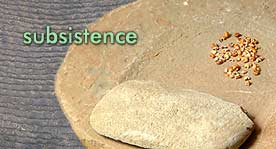
 |
Cottontail, jackrabbit, prairie dog, and turkey were also hunted as their bones are found in profusion in prehistoric trash middens in Chaco Canyon. Changes in the types of hunting gear used over time corresponded to changing animal populations, an increasingly sedentary village lifestyle, and population growth. The Chaco museum collection contains over 1,500 points, made from a wide variety of materials. These include petrified wood, chert, chalcedony, and obsidian. Unfortunately, fragile bows and arrow shafts have not survived well. Only a few fragments of historic-era Navajo made arrows remain. However, in size and style they are similar to ones reported from other Anasazi sites. The Southwestern trinity of corn, beans, and squash dominates Chaco Canyon agriculture. Corncobs survive well in the arid Southwest. Remarkably, archeologists have also found seeds such as squash, watermelon, and pinon shells. The Chacoans practiced dry farming supplemented by water control management. Canals, check dams, and ditches took advantage of the water runoff during summer storms. Digging sticks and tchamahias or stone hoes were used for planting. After the harvest, seeds were stored over the winter in seed jars. Dried corn kernels were then ground into flour using manos or hand-held round or oval grinding stones and metates, large grinding slabs, often in a series of graduated coarseness. Evidence indicates that ancient Chacoans flourished in this semiarid landscape on a varied diet of plants and animals, cultivated and wild. |
||
|
The people of Chaco Canyon were farmers, hunters, and gatherers. They made full use of the limited resources of their arid plateau and range desert environment. In the early periods, [Archaic through Basketmaker, from about 5500 BC to AD 700], hunting provided most of the food. Hunters needed large arrows or projectile points to successfully hunt large game such as mule deer, bison, mountain sheep, and elk. During this period, points were mounted on spears. The atlatl or spear thrower was used to increase thrust and propel the spear forward.
Around AD 700, with the start of the Pueblo Period, bows and arrows began to replace the atlatl. Projectile points diminished in size to fit the small reed arrow shafts. The small projectile points were suited to hunting the small mammals and birds that were plentiful and easy to capture at Chaco. |